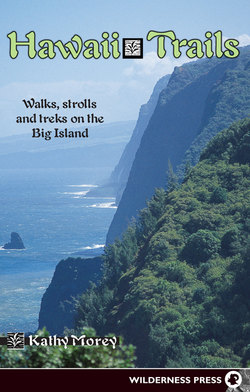Читать книгу Hawaii Trails - Kathy Morey - Страница 18
На сайте Литреса книга снята с продажи.
ОглавлениеTrip 1
Waipio Valley
Distance: 3 miles
Elevation gain: 960 feet
Hiking time: 2 hours
Topos: Kukuihaele 7½
Difficulty: Strenuous, tennis shoes okay
Highlights: When you were dreaming of visiting Hawaii, did you linger over photographs of a broad, Eden-like green valley sealed off from the outside world by sheer, thousand-foot-high walls? Chances are that valley was Waipio Valley. This is your chance to spend some time in it.
Driving instructions: From Hilo, drive northwest along the Hamakua Coast on Highway 19 for 40 miles to the turnoff to Honokaa (Highway 240). Allow plenty of time for this drive, as the Hamakua Coast is very lovely. After turning right (north) onto Highway 240, follow it through Honokaa and several smaller towns to the end of the road, 9⅓ more miles (49⅓ miles total), just above Waipio Overlook. Under no circumstances should you even consider driving down into Waipio Valley! The 4WD-only road is extraordinarily steep, narrow, and a trial even for drivers who know it well.
Permit/permission required: No permission is required for dayhiking. Permission is required from the Bishop Estate to camp overnight.
View of Waipio Valley beach from overlook
Description: Take a few minutes to walk down to Waipio Overlook to enjoy the view of the valley. Rain-drenched, dazzlingly green Waipio Valley is one of the Big Island’s most famous beauty spots. However, some of the waterfalls may be dry: their streams are tapped “topside” for irrigation, so there’s little water left to cascade down into the valley. The overlook offers the best views you’re going to get unless you decide to tackle the switchbacks you’ll see zigzagging up the west wall of Waipio Valley. This is an excellent place to take your photos of Waipio, too.
Back at the top of the road, you’ll see a sign with a black diamond on it. You’re probably familiar with the use of the black-diamond symbol to indicate the most difficult runs at skiing areas. Well, the road that you hike down into Waipio Valley is a black-diamond road—though the warning is for cars rather than hikers. Watch out for the loose gravel on the shoulders; it’s easy to lose your footing on it and fall. Ignore side roads (they’re driveways to private property).
In ¾ mile you reach the valley floor and turn right, toward the beach. As you approach the coast, you enter a grove of ironwoods and curve left through the grove (which also happens to be the camping area). The grove ends on the banks of the major stream through Waipio Valley, Wailoa Stream, 1½ miles from your start. Most of Waipio’s gray-sand beach is on the other side of Wailoa Stream, so ford the stream as best you can—no bridge, no rocks, no logs. Especially on weekends, you’ll find families frolicking in the stream, so you can watch them to get an idea of where it’s safe to cross. Some innovative people float their picnic gear across the stream on boogie boards. (At its deepest, the water was almost armpit-deep on me.)
Once across Wailoa Stream, you can wander across sand and cobbles as far as the opposite wall of the valley. Waipio’s waters are too rough for swimming, but don’t let that ruin your day. Pick your spot, spread out your towel, get out your picnic lunch, and enjoy the scenery. Much of Waipio Valley is privately owned, so you’re not free to wander through the valley. However, you can ascend the switchbacks on the west wall of the valley partway for some different but equally spectacular views of the valley. (The extra mileage and elevation gain/loss are not included in this trip.) See Trip 2 for directions to the switchbacks.
Save some energy for that monumental climb back up the road, as you must eventually return the way you came.
Waipio stories
Waipio Valley’s fertile and beautiful acres are the site of many old Hawaiian legends and the home of many of Hawaii’s heroes. The god Lono found his earthly bride here. Kane and Kanaloa once dwelt here. According to one story, the entrance from the Big Island to the underworld—where the spirits of the dead went after they were banished from the land of the living—was in Waipio Valley. It’s said that this entrance could still be found until this century, when a sugar company plowed it over while planting part of the valley in cane. Movies depicting tropical paradises often use Waipio Valley for an “Eden”—for example, “Dryland” in Waterworld.
Waipio Valley was once famous for its agricultural productivity. Reportedly, the output of Waipio Valley could sustain the entire population of the Big Island even if the crops and livestock failed everywhere else. Yet over the past 60 years, Waipio has gradually been deserted. Probably the greatest single blow to Waipio’s once-self-sufficient lifestyle was the great tsunami (tidal wave) of 1946. No one was killed in Waipio, but the tsunami, which also devastated Hilo, destroyed buildings and fields and terrified many people into leaving. Most of them never returned.
A few old-timers, as well as a few newcomers looking for Eden, still live in Waipio Valley. Waipio has no electricity, so people who want a modern lifestyle must move away, even if it’s just “topside” to the villages on the cliffs above the valley. Finally, even with modern 4WD vehicles, getting in and out of Waipio is an adventure—one that draws visitors but discourages dwellers. What will become of Waipio Valley during the twenty-first century? It’s difficult to determine yet.
